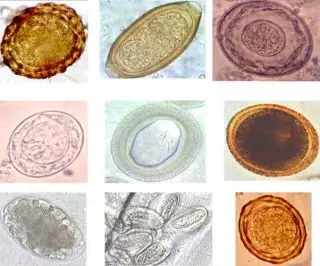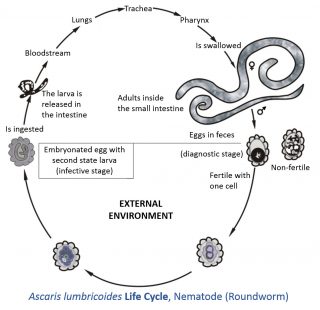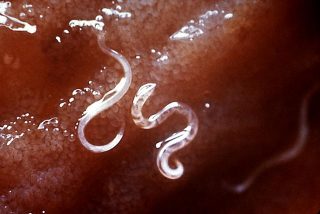Worms in Dogs – An Owner’s Guide to Identification and Treatment

By Dr Irene Mitry
Worms, or more usually their eggs are all around us. If they were visible to the naked eye, you’d be shocked at just how far and wide they are spread throughout a huge number of the environments we habitate.
Some species of female intestinal worms are capable of laying well over a staggering 200,000 eggs per day, and eventually some of them will find their way into the guts of new potential host animals, allowing the parasites to spread from host to host – often including humans.

The World Health Organiation estimates that there are over 880 million children alone in the world today requiring treatment for these pesky parasites.
A parasite is any creature that is dependent upon a separate host creature for their welfare and reproduction. And as parasites, intestinal worms have a defined “life cycle” which goes through various stages, typically according to something like the diagram below.

No matter what the species of worm, most follow a similar lifecycle. The worm’s eggs are passed into the environment via the faeces of an infected animal. Your animal then comes into contact with those eggs in soil, water or directly from the faeces itself, and ingests the embryonic eggs.
The eggs then pass through the bloodstream of your pet to one or more of the organs where parasitic worms love to make their home – most usually in your pet’s intestine. From there, the worms begin laying their huge volume of eggs, which in turn pass through your pet’s faeces back into the environment, and the cycle begins anew.
Worm eggs can even be passed to your pet via other parasites such as mosquitoes and fleas, which extract egg-contaminated blood from an infected animal and pass the eggs on to your pet when they move on to bite them. Some species can even be transmitted directly via skin contact – particularly through contaminated water. For this reason, a comprehensive anti-parasite regime that addresses these other potential sources of transmission is recommended.
Not all intestinal worms’ eggs will be fertile, but those that are are capable of living a long time, effectively dormant, in the external environment once they’ve been passed out in the stool of an infected animal or person.
While worms remain a huge problem in developing countries, fortunately with the advent of modern sanitation methods the transmission and infection rates of helminths in humans has dropped dramatically over the past hundred years or so.
Why Pet Owners Are Particularly At Risk
Pet owners are uniquely at risk because obviously our pets don’t have the benefit of sewer systems to flush all the problem matter away. Often it is we humans who are required to dispose of their unwanted stool.
Many of the same species of worm that love to make their home in our pets’ guts are just as equally at home in humans, and human pet owners naturally have greater exposure to their eggs through contact with their pets, their faeces, and the environments in which they tend to deposit it.
Which is all the more reason why we need to stay vigilant about keeping our pets as free from intestinal worms as possible. While they might seem like a benign enough issue that don’t appear to trouble our pets from day to day, a serious infestation – if it is left unchecked can cause serious health complications, or in extreme cases even death – both in our pets and in our own guts.
So, as part of our “pesky parasites” month, I thought it would be a good time to take a close look at these worms, the signs and symptoms of their presence, and what we can do to both prevent and treat the problems caused by these troublesome little creatures.
Common Intestinal Worms in Dogs and Cats
There are literally hundreds of different species of helminths in the world today, but there are four particularly common species you mostly need to worry about in relation to your pet.
Roundworm
Roundworms are by far the most common intestinal worm to infest domestic animals, with a recent veterinary study showing the species makes up between 25 and 75 percent of all worm infestations.
Roundworms grow to be between three and five inches long and eat the food your pet ingests, stealing their nutrients. Roundworm eggs can take several weeks to become infective, so for cat owners in particular, we strongly recommend making sure you clean their litter tray regularly by disposing of and replacing the litter contents completely at least once a week, and not leaving deposited faeces in the tray any longer than is necessary.
Hookworm
Hookworms are another particularly nasty, and yet common parasite. A hookworm infestation can sometimes be fatal, especially in kittens or puppies with their still-developing immune systems and reliance on obtaining a proper range of nutrients.
In their fourth larval stage, hookworms can cause anemia and inflammation in your pet’s small intestine. Active worms leave bite sites on the inner intestines which can continue to seep blood and become an infection risk in their own right.

Hookworms are too small to be seen with the naked eye – only a veterinarian can offer a definitive diagnosis. A general unhealthy appearance and poor appetite are the most common symptoms of infestation. The linings of your pet’s nostrils, lips, and ears will often also be pale and they may present with dark and tarry stool, diarrhea, or constipation. Death can come suddenly if the animal is not immediately treated, so if you see any of these symptoms, you should get them to a veterinarian for treatment as soon as possible.
Tapeworm
Tapeworm can be transmitted by your pet eating fleas or prey that has been infested with tapeworm larvae. For this reason, maintaining a regular anti-flea regime is also an excellent preventative measure against tapeworm. The worm then matures in your pet’s large intestine before its body breaks up into egg carrying segments which are then passed out in the animal’s faeces. If you notice light coloured flecks in your pet’s stool, this is usually a symptom of tapeworm infestation.
Whipworm
Whipworm is usually contracted through exposure to contaminated faeces or soil. Pets with minor infestations may not present with any visible symptoms, but in more severe cases bloody diarrhea is the most usual sign of the whipworm’s presence. In severe cases, the condition can be fatal, so if you notice any issues with blood in your pet’s stool, again you should contact your vet immediately.
Best Worm Prevention Practices for Pet Owners
The best way to prevent a worm infestation is to avoid contact with worms, and particularly their eggs. And the unfortunate reality is that in a lot of cases this advice is simply not feasible.
Indoor cats are at an advantage relative to the rest of us, given they naturally have less exposure to worm-y environments, but as we’ve seen already, fleas and mosquitoes can often be transmission vectors, and it’s practically impossible to keep your house completely sealed off from such intrepid critters as those.
So really, everyone needs to be on the alert. Our dogs in particular not only like to spend a lot of time in the sorts of environments that worms tend to make a home, but they also actively seek out the stool of other animals while they are out and about, making them particularly susceptible to infestation.
Cat owners, as we have already seen, are advised to keep their litter tray as fresh as possible, with regular changes of the entire litter, and if possible cleaning of the tray itself can help wash away any remnant eggs that may be lurking there. Not allowing stool to sit in the tray for any significant period of time will also be of benefit.
All-In-One Worm Prevention
But the best way of giving yourself peace of mind about the possibility of your pets contracting worms is to regularly use one of the many brands of deworming medications that are available on the market today.
There are nearly as many types of dewormers for dogs and cats as there are species of worm. These include chewable medications, injections or orally-induced liquids. Many of these drugs are described as “broad-spectrum,” because they’re good for treating a wide range of parasites, including worms that live in the gut. They’re poisonous to parasites, but safe for pets.
While we don’t necessarily prefer any particular brand, your choice should be informed by what other parasites they are likely to routinely come in to contact with, as most common brands today act as an “all-in-one” anti-parasite medication, which can also prevent them from coming under attack by other nasties like fleas, ticks and heartworm.
Because new kittens and puppies are so susceptible to contracting worms, and vulnerable to the worst effects, we recommend having all new kittens and puppies dewormed at 2 week intervals until they are at least 12 weeks old, with follow-up boosters as necessary.
But it’s not just the most common pets like dogs and cats who can benefit, many common all-in-one medications such as “Spot On” topical anti-parasite medication, which is quickly and easily applied to your pet’s skin is also effective on other species such as rabbits. Ferrets are also able to be treated using other species-specific medications.
We advise that dogs or cats, in particular, should at minimum have an annual checkup for the presence of worms and other parasites, increasing to 2-4 times a year for new puppies and kittens, given the higher risks to younger animals.
Book an Appointment Today


